Megachurches Today 2000
Summary of data from the
Faith Communities Today
2000 Project
Principal Investigator Scott Thumma, Ph.D.
posted 2001

Index:
Introduction
Overview of the Project
Findings:
Conclusions
*Read
the November 2001 press release "Megachurches
cluster in Bible belt, study shows"

Introduction
Much
of what we know about very large congregations is not derived from social
scientific research. We have learned about the birth, success and
functioning of large churches by reading experiential accounts written by
either pastors or church consultants. These efforts have their place, but
they seldom do justice in mapping the diversity of large congregations,
nor in identifying the nuances within this phenomenon.
Until
this present effort, in conjunction with the Faith
Communities Today (FACT) project, no systematic study of the full range of megachurches
had been undertaken with the intent to map their characteristics, growth
patterns, or programmatic efforts. For this report, we define the size of a megachurch
as a congregation with an average weekly worship
attendance of 2000 or more.
A
question we have been asked repeatedly is why survey megachurches
separately for the FACT project. Since any random sampling of the Southern
Baptist Convention, the Assemblies of God, and United Methodist Church as
well as other denominations, would inevitably include very large
congregations; what is the need to question these congregations
separately?
Whether
we like it or not, very large congregations are viewed as the trendsetters
of the contemporary Christian world. These success stories are read by
thousands of pastors and members alike as what they want to grow into.
Even if a small congregation doesn’t desire to have a 3500 person
worship service, they still look to the programmatic characteristics of
the megachurch for clues about what their congregation should be doing.
And even if there are congregations who would not agree with these
statements, all churches – including the megachurches themselves –
have mistaken impressions (both positive and negative) about these large
congregations because so little actual research has been done on
them. 
Yet,
any national survey of congregations would collect information on only a
few megachurches since they represent a very small percent (less than 1
percent) of the total number of congregations in any denomination.
Therefore, the only way to get a good snapshot of the characteristics of
these influential congregations was to survey them as an independent
population and then later adjust (weight) their scores relative to their
actual distribution in the total population of congregations in the United
States.
The
pastors of a total of 600 megachurches were mailed the questionnaire which
contained the core Faith Communities Today questions plus several
additional items (view
the full questionnaire). These 600 churches were from an existing
database of known megachurches. After email reminders, a total of
153 usable forms were collected, for a response rate of 25.5
percent.
The
following report is an initial summary of some of the findings of this
research. Over the following months continued in-depth analysis of this
information will take place. Occasional research notes will be posted on
the megachurch
project page. 
The
survey of megachurches was undertaken and analyzed by Dr. Scott Thumma,
assisted by Dr. John
Vaughan, endorsed by the Leadership Network of Dallas, Texas and funded by
the Lilly Endowment and Hartford Seminary. This brief summary report, compiled and
written by Dr. Scott Thumma, focuses on information from the responses
from the megachurch key informants.
This
information should not be assumed to be representative of the over 600
Protestant megachurches in the United States. This study, however, does
offer an initial systematic glimpse at some of these influential religious bodies.
Overview of the Faith Communities Today Project
FACT was a cooperative venture of over 40
religious groups and denominations. Professors Carl Dudley and David
Roozen of the Hartford Institute for Religion Research, Hartford Seminary
coordinated this research project.
The strategy of the project was to recruit
social scientists from within different faith
traditions to jointly shape and distribute a common core questionnaire to
key informants within their congregations. Using this questionnaire, the
project collected parallel information on 14,301 faith communities.
After several years of planning and
consultation, this project was completed and the overall findings
officially released on March, 13th 2001. The project received,
and continues to generate, considerable publicity with
news reports in over 150 newspapers, as well as radio, and television
stations.
It is possible to view and print a free copy
of the research report of the findings at the project’s web site http://FACT.hartsem.edu.
On the site you will also find many other ways to explore and examine the
Faith Communities Today data from over 14,000 congregations.
At the web site you can also interact with
portions of the survey information in the section called the
"Interactive
Workbook." This Workbook was designed so that local
congregations could use the Faith Communities Today data to look at their
own practices and reflect on their ministry and mission. We encourage you
to visit the online workbook, organize a study group and compare your own
group’s scores to those of other congregations who are trying to be
faithful servants of their God in the world.

Findings
From The Report
Size
The
most obvious characteristic of megachurches is their size. The
average weekly worship attendance was 3857 persons. Roughly 50
percent of the churches had between 2000 and 4000 in attendance, with
almost 15% reporting 6000 or more attenders. Interestingly almost
the same percentage of churches reported worship attendance less than
2000, mostly in the 1800-1900 person range. These congregations have
been left in the analysis.

Two-thirds of the
responding megas planted "daughter churches," with the majority
planting 5 or less. Slightly less than a fourth have satellite
worship sites, but nearly all of these "branch campuses" offer
distinctively different worship styles from the main church. 

Growth
Over
the past twenty years, the attendance of the churches in this survey
increased by an average rate of 90 percent. In the last five year, the
weekly worship attendance for three-quarters of these congregations grew
by 10 percent or more. During that same period, however, twelve
percent of surveyed churches lost members.
Location
Forty
percent of megachurches are found in the South, 32% in the West, and 21%
in the Midwest, but only six percent in the Northeast. The states
with the greatest concentration include California, Texas, Florida, and
Georgia.
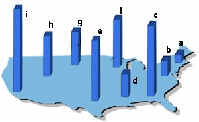 |
Region |
Percent |
a.
New England
b. Middle Atlantic
c. South Atlantic
d. East South Central
e. West South Central
f. East North Central
g. West North Central
h. Mountain
i. Pacific + AK & HI |
2.0%
4.0
18.5
6.0
15.9
12.9
8.6
10.6
21.9 |
Megachurches
are predominantly a phenomenon of the suburbs of very large cities.
Sixty-three percent are located in or around cities of 250,000 or more,
with 23% in cities between 50,000 and 250,000. Nearly three quarters
of the churches reside in the older or newer suburbs of these large
cities. 
Founding Date
Megachurches
are both an
old and new phenomenon. Fifty-seven
percent for these churches were founded before 1961.
Year
Congregation Was Founded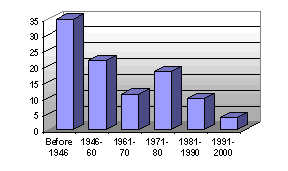
On the other hand,
nearly two-thirds of the congregations moved into their current
locations after 1970, with 20% moving in the last decade.
Year
Church Moved to Its Current Location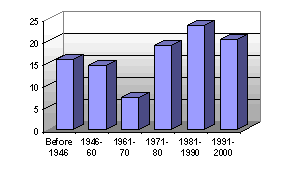
The
majority of these congregations report that their tremendous growth has
taken place in the past 25 years. Seventy percent of
these churches report that they experienced their rapid growth within the
tenure of their current pastor, and 1987 was the average year the current
pastor was called.
Facilities
The median seating capacity in the surveyed
sanctuaries is 1700 persons. A quarter of congregations have sanctuaries
that seat more than 2500 people and 5% had seating for 5000
or more, but 18% seat 1000 or less. Fifteen percent of the churches
allow other congregations to use their worship space. Even as large
as they are, a majority of the megachurches feel they have insufficient
space for their ministry.

Worship
All megachurches offer an opportunity for
worship on Sunday mornings, 20 percent also have a Friday service and
nearly half have a service on Saturday. Sixty-five percent have a Sunday
evening service. The average attendance on Sunday mornings is 2913 people.
Ninety-three percent offer two or more services on Sunday morning, 48%
have three or more.
A majority of congregations report that
worship always or often includes:
-
Sermons (100%)
-
Organ and/or piano music (92%)
-
String
or wind instruments (79%)
-
Time for people to greet each other (93%)
-
Altar call for salvation (60%)
-
Prayers for healing (45%)
-
Speaking
in tongues (17%)
The worship and music style in a large number
of nondenominational congregations appears to have a contemporary and electronic component in the service always or quite often.
-
Seventy-two
percent use visual projection
equipment.
-
75-80 percent of churches use
electronic keyboards and guitars, and drums.
-
Forty-three
percent include recorded
music in the service.
-
22
percent report they use dance or drama always or quite often.
Nearly
a quarter (21%) of congregations report that their
primary worship service has changed a lot in the last five years, with the
same percent (21%) reporting somewhat of a change. The rest of the
churches report that worship is either
basically the same (22%) or has changed only a little (37%).
Preaching
Respondents say that sermons during the worship service MOST
often always focus on:
-
God’s love and care (44%)
-
Personal salvation (42%)
-
Personal spiritual growth (38%)
-
Practical advice for daily living (34%)
The sermons LEAST often always focus on:
-
The End Times/ Second Coming of
Jesus (1.0%)
-
Stewardship of time and money (5.0%)
-
The gifts of the Holy Spirit
(11%)
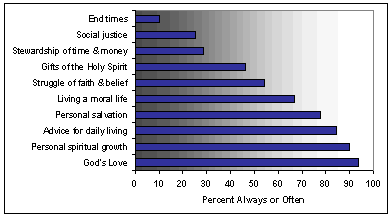
These sermon messages are always or often combined
with personal stories or
first-hand experiences of the pastor (75%), illustrations from contemporary
media (75%) and detailed explanations of scripture (57%) rather than literary or scholarly references
(30%).
Theology
Ninety-two percent of megachurches state the Bible is absolutely
foundational as a source of authority. 88% of respondents name the Bible as the one most
important authority for their congregation's worship and teaching, while
8%, historic creeds,
doctrines, and tradition, 6% name the inspiration of the Holy Spirit, and
6% say the one source of authority is the congregation vision and
purpose.
In terms of theology of the congregation, the
label respondents selected to best fit their membership were as follows:
-
Evangelical 48%
-
Charismatic 14%
-
Pentecostal 11%
-
Moderate 12%
-
Traditional 8%
-
Seeker 3%
-
Fundamentalist 2%
-
Other 3%
Pentecostal and Charismatic congregations
accounted for roughly 25 percent of the respondents, judging by the
chosen theological labels (25%), the sometimes to always use of speaking in tongues in
the service (26%), and the fact that 25% agree that the statement
"our congregation encourages the public expression of speaking in
tongues" fits them very well to somewhat.
Participants and
Members
Counting everyone involved in congregational life (including both members and non-members however irregular their
participation), yields an average of 6,876 persons per megachurch. The average number of regular adult
participants is 3392. The average number of regular participants under
the age of 18 is 1348.
Demographics of
the Regularly Participating Adults
The percentages of congregations
which reported that…. |
20 percent or less of
their members: |
Over 60 percent of
their members: |
are female |
0% |
5.2% |
have less than a high school diploma |
83.2% |
3.1% |
are college graduates |
7.0% |
25.3% |
are aged 35 or less |
6.1% |
9.8% |
are older than 60 years |
51.1% |
3.0% |
are married |
3.8% |
30.5% |
have children under 18 years at home |
7.9% |
6.3% |
live near the church |
36.1% |
15% |
live more than 15 minutes drive from
the church |
23.2% |
11.9% |
live in households with less than
$20,000 annual incomes |
83.3% |
.8% |
live in households with more that
$75,000 annual incomes |
29.0% |
13.0% |
are new to the congregation in the
last five years |
29.1% |
9.7% |
are life long members of
nondenominational churches |
34.1% |
22.5% |

Race of the
Regularly Participating Adults
Nearly all the congregations have some minority racial presence. Nearly
50% of the white congregations have 10% or more regular minority adult
participants. 16% of churches without a Hispanic majority have
significant (10-49%) Hispanic presence among their regular
attenders. Twelve percent of churches without a black majority have
significant (10-49%) black presence among their regular attenders.
| |
Average percent per congregation |
Percent of churches
with more than 50% of participating adults |
American
Indian/Alaska Native
Asian
Black or African-American
Hispanic or Latino
Hawaiian/ Pacific Islander
White
Biracial/Multiracial |
0.6%
2.1
10.5
5.5
0.9
79.5
1.7
|
0.0%
0.0
6.7
1.4
0.7
85.8
0.0
|
Congregational Programs
It is a well known fact that megachurches offer a multitude of programs and
ministries for members to choose from. This data allows us to see
both that wide assortment of programs and the rate at which they are offered.
Ninety-five percent of megachurches have a weekly Sunday school
program. The average total weekly adult attendance at this Sunday school
is 856 with an average of 788 children under 18 years of age. Over
seventy percent said their teenagers were involved in the life of the church
to a very great or large extent.
Percent
of Churches Reporting Teen Involvement
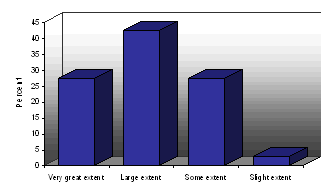
In addition to the regular Sunday school programs, other programs
were offered as on-going events throughout the year, on average, by
the following percentages in megachurches.
- Bible studies 78%
- Prayer groups 83%
- Youth/teen activities 94%
- Men's/women's ministries 86%
- Spiritual Retreats 34%
- Young Adult activities 83%
- Choirs 85%
- Community Service programs 65%
- Parenting/marriage classes 52%
- Senior Adult activities 82%
- Self-help groups 57%
- Sports/Fitness teams 59%
- National Parachurch programs 53%

Outreach to New Members & Visitors
Megachurches do not get to the size they are without an active evangelism
emphasis. Thirty-eight percent of megachurch respondents say their
current members are involved in recruiting new members at moderate
levels and another 29 percent of churches reported extensive
recruitment involvement on the part of their members. Thirty percent of
congregations report minimal recruitment with only 4 percent saying
their members are not at all involved in evangelistic efforts.
Ninety-six percent of congregations strongly encourage their new members
to volunteer in church ministries.
Over three quarters of churches (76%) require new members to take an
informational class prior to or after joining.
A third of those megachurches surveyed said they assign a pastor or
lay leader to mentor new members into becoming incorporated members of the
church.
Nearly three-quarters (74%) of churches thought that new members
were very or quite easily incorporated into the life of their church.
Slightly over 50 % provided
special parking for visitors, and around 40% acknowledged them in a demonstrative
manner such as making them stand, raise their hand or receiving a visitor
label.
Somewhat surprising for these massive congregations, nearly fifty percent
thought the statement that their church feels like a close-knit family
described them very or quite well.
This is in part due to
the extensive use of small group fellowship in megachurches, 50% say their
use is central to their strategy for Christian nurture and spiritual formation.
Another 44% have such groups but say their are not central to the
church's program. Over eighty percent say they have an organized program
for keeping up with members' needs and providing ministry at the neighborhood
level.
96% of respondents thought church members were very or quite excited about
the future of their church and 90% thought the statement that the congregation
was spiritually vital and alive described them very or quite well.
86% of the megachurches that the statement that they had a clear sense
of mission and purpose described their church very or quite well.
Service to the Community
Almost all megachurches (99%) provide some sort of food assistance
(either through a food pantry or soup kitchen) to the needy in their
communities. Other service programs that megachurches said they provided or supported independently included:
Congregational Social Ministry Programs
(Support is defined as material or financial contribution,
member volunteer time, or space in building. Percent of churches reporting
these activities.)
-
cash or vouchers given to families or individuals 91%
-
programs for youth and teens 99%
-
counseling services or support groups 95%
-
hospitals & nursing homes 80%
-
prison ministries
91%
-
thrift store or thrift store donations 78%
-
temporary or permanent housing/shelter 78%
-
senior citizen programs 84%
-
substance abuse & 12 step programs 85%
The average number of volunteer workers (giving 5 or
more hours a week to the church) was 297.
Percent
of Churches reporting size of Volunteer Pool (giving
5+hours/week)
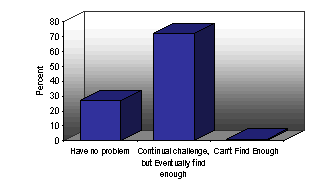
Denominational Affiliations, Networks and Interfaith Involvement
Sixty-seven percent of megachurches in this survey belonged to an organized
denomination. Denominational information will be posted soon.
Other questions
in the survey indicate the megachurches ties to their denominations were tenuous
at best. Only 37% thought the statement "Our congregation clearly
expresses its denominational (or nondenominational stance) heritage" described
them very or quite well. Likewise, the authority of the denominational
leaders was rated foundational or very important for just 29 percent of churches.
Only 27 percent of these megachurches purchased worship, educational
and other programmatic supplies and resources exclusively or primarily from
sources within their denomination. On the other hand, 43% created their
own, or bought exclusively or primarily from sources outside their denomination.
Roughly thirty percent said they were independent or nondenominational. Twenty
percent of the respondents belonged to a belonged to a Network, Fellowship
or Association of churches. These networks ranged anywhere
from 15 members to several thousand. The median network size
was 600 churches.
Megachurches were also involved with churches in other ways. Many participated
in doing the social ministries listed above, although at only one third
the level they were active by themselves.
They also participated in activities with other congregations
within their respective denominations (or if independent - with other independent
churches) and with congregations from other Christian bodies. Interestingly
they participated in activities with congregations of other denominations
at higher rates than they did with churches within their denominations.
| How
often are is your church involved in these activities with other
churches from: |
Our
Denom. |
Other
Christian Denoms. |
Other
Faith traditions |
Joint worship
services
Joint programs/celebrations
Social outreach programs
Church councils, min. assoc.
|
26%
24%
26%
19% |
34%
32%
41%
33% |
12%
14%
14%
12% |
Slightly over one in ten megachurches reported any kind of interfaith
activity with congregations from other faith traditions.
Many of the megachurches
sponsored pastor's or ministerial conferences (47%). Nearly 42% operated
their own Christian school, and 30% had a Bible school or Institute.
Forty-four percent had
a radio ministry and nearly the same number (38%) ran a television ministry.
The Internet was another way these congregations were
present within the larger Christian community. Nearly 100 percent had
a church email address. In early 2000, 99 percent of these congregations
also had a web site. It is possible to explore the web sites of these
and other megachurches at the online megachurch database. 
Finances
Fifty-four percent of megachurch respondents describe the current financial
health of their congregation as excellent, and another third say it is good.
This financial picture has improved considerably since 1995 when only
30 percent rated it as excellent and 40% as good.
The average total annual income of the megachurches in the study for
1999 was 4.8 million dollars.
The average expenditures in 1999 for these same churches totaled 4.4 million dollars.
Leadership
Ninety-eight
percent of the congregations report they currently have a
full time senior pastor.
On average the senior pastor is 52 years of age and has been
at the congregation over 12 years. Ninety-nine percent of these pastors
are male. Eighty-eight percent are white, six percent are African American
and six percent were of other racial and ethnic backgrounds including
Hispanic, American Indian, and "other."
These pastors are generally well educated with 97% having secular
college degree or higher. In terms of ministerial education, 5 percent had no training
or a certificate, 22 percent went to Bible college or had some seminary
training and 73 percent had a seminary degree or better.
These megachurches averaged
13 full time paid ministerial staff persons, and 25 full time paid program
staff persons. The average number of volunteer workers (giving 5 or
more hours a week to the church) was 297.
Even given these numbers,
72% said that recruiting volunteer leaders is a continual challenge, but
that they eventually find enough willing people. Only 27% said they
did not have any problem getting volunteer leaders.

Conclusions
What can we tell from this information? The primary finding
from this study is that megachurches have many common characteristics but
that there are important differences within the group. All megachurches
are not carbon copies of Willow Creek Community Church, Calvary Chapel, Saddleback Church or even First Baptist of Dallas. And the distinctions
between churches may be as important as the similarities. Clearly there are several
distinct types, or forms, of megachurches although
more detailed analysis of this data must be done to isolate these unique
groupings.
The misconceptions about megachurches
abound. Yet this initial and somewhat sketchy data does not confirm many
of the stereotypes Americans have of megachurches. The survey
reports that this sample was, for the most part, solidly middle class
in its membership. They are also more diverse racially than most
evangelical, moderate and mainline congregations. Therefore, a
secondary learning is that much more research needs to be undertaken
on this very prominent, but understudied, segment of American
religion.
Many megachurches have been around a very long time and others, roughly
15%, are less than 20 years old. However, nearly all of the growth of
megas has taken place in the past two to three decades. Megachurches are
located everywhere in the United States, but they do have areas
of concentration,
including California, Texas, Florida and Georgia. They are primarily Evangelical and Pentecostal in their
theology, but a sizable minority does fall within the moderate and mainline
denominations. 
These congregations are not blind to the world's or their local
community's needs. The congregations are very active in social ministry
areas, targeted both at its membership and also at those outside its
walls. These efforts are more likely accomplished through their own
congregational efforts rather than in conjunction with other churches or
external ministry and mission organizations.
Likewise, this data points to the somewhat tenuous relationship megachurches
have with their affiliate denominations. They seem considerably less involved
with their denominational structures, less dependent on denominational resources and less
likely to interact in joint projects with churches from its own denomination
than from churches outside its affiliate religious organization. 
The
rapid growth of megachurches on the United States landscape shows very
little sign of diminishing. However, this information collected
begins to show how complex these large churches are and how little we know
about them as a total group.
Over
the coming months, additional analysis of this data may shed new light on
how and why these congregations grow as they do. In comparison to
the full Faith Communities Today dataset, we may be able to also obtain a
more accurate picture of how these megachurches are similar to and
different from smaller congregations.
If you are interested in other reports about megachurches:
- Read a summary article about the characteristics of megachurches from
this author's previous research.
- View the online megachurch
database.
Email your questions and comments to Scott
Thumma at sthumma@hartsem.edu.
|
